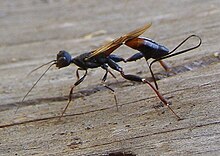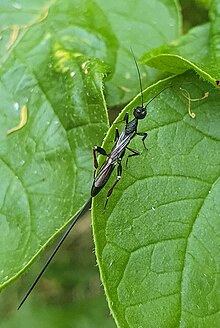33:
234:
54:
281:. It is usually found in forests or other rural locations, but when recorded from Romania for the first time in 2015, the wasps were found on a timber shed in an urban environment. Other non-natural habitats where it has been observed include fencing, utility poles, wooden boarding and stacked firewood, in each case attracted by beetle larvae within.
317:. Boring may take many hours, with rests in between the boring efforts, at which times the females withdraw their ovipositors. They seem to be able to re-locate the hole they were working on when they recommence boring. As the ovipositor is pushed deeper into the wood, the sheath arches upwards in a loop.
272:
is known from Spain, France, Netherlands, Italy, Germany, Switzerland, Austria, Czech
Republic, Hungary, Romania, Bulgaria, Croatia, Serbia and Montenegro. Adults can be found on and around trees that have been dead for about a year and which contain beetle larvae, but which have not yet been invaded
312:
spp. sometimes feed on the wasps, but the wasps usually manage to evade them. Female wasps that are trying to locate beetle larvae in wood adopt a characteristic posture with fore and hind legs spread widely, middle legs folded tightly against the body, antennae lowered and ovipositor sheath pressed
324:
parts. When fully developed they pupate in the galleries left by the beetle larvae. Male wasps emerge some ten days before the females and adopt a similar search posture, perhaps waiting for the females to emerge.
675:
313:
against the wood; they then move a few centimetres to a new location and repeat the process. When a potential target is located, the ovipositor is bored into the
606:
217:, the crown wasps. This species is native to much of Europe and is to be seen in the breeding season on recently dead timber or wood products. The larvae are
261:
of 11.4 mm (0.45 in). The slender body and legs are black, apart from the front half of the abdomen and certain leg segments, which are red.
580:
320:
The eggs are laid in the galleries created by the beetle larvae. The developing wasp larvae feed on the beetle larvae, rejecting the most heavily
412:
670:
541:
241:
Stephanid wasps are known as crown wasps because the top of the wasp's head bears a group of five tubercles. The somewhat elongated
665:
515:
611:
559:
300:. Despite being able to fly, these wasps usually move about by walking and usually avoid sunlight. Spiders such as
165:
53:
32:
572:
250:
352:
483:
520:
660:
148:
528:
314:
302:
174:
48:
257:
averages 9.5 mm (0.37 in) in length and the female 13 mm (0.51 in), with an
632:
428:
408:
390:
637:
418:
398:
371:
125:
619:
567:
554:
423:
278:
452:
375:
654:
308:
506:
593:
233:
214:
115:
105:
293:
258:
218:
41:
546:
403:
246:
242:
85:
65:
432:
624:
500:
585:
210:
598:
321:
297:
222:
95:
75:
477:
391:"A revision of the Chinese Stephanidae (Hymenoptera, Stephanoidea)"
274:
232:
533:
389:
Hong Chun-dan; van
Achterberg, Cornelis & Xu Zai-fu (2011).
481:
253:, and the ventral side of the hind femur bears teeth. The male
277:; this wasp has been recorded parasitising several different
451:
Hausl-Hoffstatter, Ulrike & Bojar, Hans-Peter (2016).
357:(Fabricius, 1798) in Romania (Hymenoptera: Stephanidae)"
490:
457:(Fabricius, 1798) (Hymenoptera: Stephanidae)"
446:
444:
442:
249:(the first abdominal segment) by a very long
8:
478:
31:
20:
422:
402:
346:
344:
342:
340:
338:
676:Taxa named by Johan Christian Fabricius
351:Lakatos, T.K. & László, Z. (2015).
334:
453:"Behaviour, biology and morphology of
7:
573:81446914-effe-4bc8-88f8-efaf06047381
14:
376:10.17112/FoliaEntHung.2015.76.241
213:of parasitic wasp in the family
52:
397:(110). PenSoft Publishers: 2.
1:
296:of the larvae of wood-boring
221:of the larvae of wood-boring
364:Folia Entomologica Hungarica
692:
671:Insects described in 1798
237:Stephanus serrator female
180:
173:
154:
147:
49:Scientific classification
47:
39:
30:
23:
195:Jurine (in Panzer), 1801
404:10.3897/zookeys.110.918
238:
666:Hymenoptera of Europe
236:
568:Fauna Europaea (new)
245:is connected to the
192:Stephanus coronatus
492:Stephanus serrator
455:Stephanus serrator
355:Stephanus serrator
303:Nuctenea umbratica
239:
206:Stephanus serrator
184:Ichneumon serrator
158:Stephanus serrator
25:Stephanus serrator
648:
647:
633:Open Tree of Life
484:Taxon identifiers
414:978-954-642-596-6
202:
201:
196:
188:
683:
641:
640:
628:
627:
615:
614:
602:
601:
589:
588:
576:
575:
563:
562:
550:
549:
537:
536:
524:
523:
511:
510:
509:
479:
472:
471:
464:Joannea Zoologie
461:
448:
437:
436:
426:
406:
386:
380:
379:
361:
348:
194:
186:
160:
140:S. serrator
57:
56:
35:
21:
691:
690:
686:
685:
684:
682:
681:
680:
651:
650:
649:
644:
636:
631:
623:
620:Observation.org
618:
610:
605:
597:
592:
584:
579:
571:
566:
558:
553:
545:
540:
532:
527:
519:
514:
505:
504:
499:
486:
476:
475:
459:
450:
449:
440:
415:
388:
387:
383:
359:
350:
349:
336:
331:
287:
267:
231:
187:Fabricius, 1798
169:
162:
156:
143:
51:
17:
12:
11:
5:
689:
687:
679:
678:
673:
668:
663:
653:
652:
646:
645:
643:
642:
629:
616:
603:
590:
577:
564:
555:Fauna Europaea
551:
538:
525:
512:
496:
494:
488:
487:
482:
474:
473:
438:
413:
381:
333:
332:
330:
327:
286:
283:
266:
263:
230:
227:
200:
199:
198:
197:
189:
178:
177:
171:
170:
163:
152:
151:
145:
144:
137:
135:
131:
130:
123:
119:
118:
113:
109:
108:
103:
99:
98:
93:
89:
88:
83:
79:
78:
73:
69:
68:
63:
59:
58:
45:
44:
37:
36:
28:
27:
16:Parasitic wasp
15:
13:
10:
9:
6:
4:
3:
2:
688:
677:
674:
672:
669:
667:
664:
662:
659:
658:
656:
639:
634:
630:
626:
621:
617:
613:
608:
604:
600:
595:
591:
587:
582:
578:
574:
569:
565:
561:
556:
552:
548:
543:
539:
535:
530:
526:
522:
517:
513:
508:
502:
498:
497:
495:
493:
489:
485:
480:
469:
465:
458:
456:
447:
445:
443:
439:
434:
430:
425:
420:
416:
410:
405:
400:
396:
392:
385:
382:
377:
373:
369:
365:
358:
356:
347:
345:
343:
341:
339:
335:
328:
326:
323:
318:
316:
311:
310:
305:
304:
299:
295:
291:
284:
282:
280:
276:
271:
264:
262:
260:
256:
252:
248:
244:
235:
228:
226:
224:
220:
216:
212:
208:
207:
193:
190:
185:
182:
181:
179:
176:
172:
167:
161:
159:
153:
150:
149:Binomial name
146:
142:
141:
136:
133:
132:
129:
128:
124:
121:
120:
117:
114:
111:
110:
107:
104:
101:
100:
97:
94:
91:
90:
87:
84:
81:
80:
77:
74:
71:
70:
67:
64:
61:
60:
55:
50:
46:
43:
38:
34:
29:
26:
22:
19:
661:Stephanoidea
491:
467:
463:
454:
394:
384:
367:
363:
354:
319:
309:Parasteatoda
307:
301:
289:
288:
279:host species
269:
268:
265:Distribution
254:
240:
205:
204:
203:
191:
183:
157:
155:
139:
138:
126:
24:
18:
594:iNaturalist
370:: 241–249.
290:S. serrator
270:S. serrator
255:S. serrator
229:Description
219:parasitoids
215:Stephanidae
116:Stephanidae
106:Hymenoptera
42:ovipositing
655:Categories
329:References
322:chitinised
294:parasitoid
259:ovipositor
86:Arthropoda
507:Q14855828
315:substrate
247:propodeum
243:prothorax
166:Fabricius
134:Species:
127:Stephanus
72:Kingdom:
66:Eukaryota
501:Wikidata
470:: 15–38.
433:21852933
175:Synonyms
112:Family:
82:Phylum:
76:Animalia
62:Domain:
612:1115617
586:4498242
534:3834904
424:3119843
395:ZooKeys
298:beetles
285:Ecology
251:petiole
223:beetles
211:species
168:, 1798)
122:Genus:
102:Order:
96:Insecta
92:Class:
40:Female
638:377404
625:185825
599:735484
521:311903
431:
421:
411:
560:83684
547:90298
542:EUNIS
460:(PDF)
360:(PDF)
292:is a
275:fungi
209:is a
607:NCBI
581:GBIF
516:BOLD
429:PMID
409:ISBN
306:and
529:EoL
419:PMC
399:doi
372:doi
273:by
657::
635::
622::
609::
596::
583::
570::
557::
544::
531::
518::
503::
468:15
466:.
462:.
441:^
427:.
417:.
407:.
393:.
368:76
366:.
362:.
337:^
225:.
435:.
401::
378:.
374::
353:"
164:(
Text is available under the Creative Commons Attribution-ShareAlike License. Additional terms may apply.

